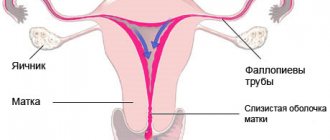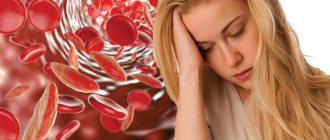When trying unsuccessfully to get pregnant, women begin to pay more attention to the menstrual cycle. They calculate the “stray” days and carefully monitor the duration of menstruation, forgetting to check the quality of ovulation. But the presence of critical days is not yet an indicator that the body is ovulating. The anovulatory cycle (anovulation) is one of the most common causes of female infertility.
Appointment with a gynecologist - 1000 rubles. Comprehensive pelvic ultrasound - 1000 rubles. Appointment based on ultrasound or test results - 500 rubles (optional)
CLICK TO MAKE AN APPOINTMENT, TEST OR ULTRASOUND
What is ovulation and how is it related to pregnancy?
The content of the article
The body of a healthy sexually mature woman is fully adapted for conception, bearing a child and childbirth. The fact that everything is in order with the reproductive system can be judged by the stability of monthly processes - ovulation and menstruation.
Ovulation is the maturation and release of a mature egg from the ovary into the fallopian tubes for fertilization. Menstruation is bleeding that removes from the uterus the mucous layer (endometrium), which forms each new cycle, and the unfertilized egg. If fertilization occurs, the egg attaches to the walls of the uterus, and menstruation does not begin.
After childbirth, the cycle resumes, and so on every month from year to year. But sometimes, for some reason, the egg is not formed or does not mature. A pathological condition in which the release of an egg ready for fertilization does not occur is called anovulation.
The anovulatory cycle is a period of menstrual bleeding in one phase, during which there is no ovulation and formation of the corpus luteum. The regularity of menstruation may be maintained.
There are two types of anovulatory cycle:
- physiological - normal;
- pathological - requiring treatment.
Anovulation can occur from time to time, up to several times a year, and this is considered normal. With age, such failures occur more often, smoothly flowing into menopause. But it happens that even a young woman does not ovulate at all - this is a good reason for diagnosing and treating infertility.
Types and causes of endocrine infertility
A woman's reproductive health is regulated by the endocrine interaction between the pituitary gland, hypothalamus and ovaries. The key hormonal factors in this regard are luteinizing hormone (LH) and follicle-stimulating hormone (FSH), as well as estradiol. Anovulatory infertility can be caused by any disorder in this chain:
- Insufficiency of gonadotropic hormones (type I);
- Polycystic ovary syndrome (type II);
- Premature depletion of ovulatory reserve (type III).
Less common factors that provoke anovulation include hypothyroidism and hyperprolactinemia. Diagnosis and therapy for each type of disease has its own characteristics.
What is an anovulatory cycle?
As the name suggests, an anovulatory cycle is a period when a woman misses ovulation. For those who do not plan to have children, use contraception, or do not attach any importance to it, anovulation often occurs unnoticed. This is due to the peculiarity of menstrual bleeding - periods can occur as usual. In a normal menstrual cycle, the production of the hormone progesterone, which regulates bleeding during menstrual periods, is stimulated by the release of the egg. It is this hormone that helps a woman’s body maintain regular periods. During the anovulatory cycle, insufficient levels of progesterone can cause uterine bleeding of a different nature, which is mistaken for menstruation.
Why is there no ovulation?
Ovulation is the most important event of every menstrual cycle. This is the rupture of follicles (vesicles) on the ovary, during which a mature egg is released, necessary for fertilization. This does not happen with anovulation.
Anovulation is most often caused by a violation of the secretion of hormones: from the hormones of the hypothalamus through the hormones of the pituitary gland, up to the hormones of the ovaries, as a result of which there is no monthly maturation of the egg and, accordingly, menstruation.
There are some other possible causes of anovulation:
- poor nutrition;
- stress;
- excessive fatness or thinness;
- intense physical activity;
- environmental change.
These symptoms are often related. Anovulation, for example, can occur with regular and intense workouts that cause sudden weight loss. Of course, this does not mean the need to stop training, you need to adjust the exercises and slow down the pace. Physical activity must be adapted to capabilities that will develop over time and require additional effort.
Likewise, menstrual irregularities and anovulation are common in very thin women. The reason for this may be not only your physique, but also a stressful situation that forced you to lose weight. It is possible that we are talking about more severe forms of the disease, for example, anorexia or bulimia.
There can be many causes, so it is important to monitor symptoms.
Causes of anovulation
A menstrual cycle without ovulation is most common in two different age groups:
- Girls who have just entered the period of growing up
. Teens typically experience anovulatory cycles for a full year after their first period (menarche). - Women approaching menopause (age 40 to 50 years)
. Significant hormonal changes occur in their body.
In both cases, the lack of ovulation is caused by sudden changes in hormone levels.
Women of the active childbearing period have chronic anovulation. Causes:
- hormonal (endocrine) disorders, ovarian dysfunction;
- inflammatory diseases of the reproductive system, STIs;
- too high (obesity) or too low body weight (anorexia);
- extreme physical activity;
- late puberty, early menopause;
- high levels of the hormone prolactin;
- severe stress
- climate change.
There are other possible reasons, for example, underdevelopment of the ovaries, genetic problems, etc.
Indirect signs of anovulation, indicating hormonal disorders:
- hair growth on the face and body in uncharacteristic places;
- acne;
- bleeding or spotting outside the cycle;
- problems with conception.
Symptoms
If, without protection, a couple does not become pregnant within a year and sexual intercourse is regular, then we can talk about infertility.
Anovulatory infertility can be suspected based on the following symptoms:
- absence of pain in the lower abdomen in the middle of the cycle and malaise previously characteristic of ovulation;
- development of bleeding regardless of the menstrual cycle;
- change in the nature of menstrual flow, duration;
- weight loss.
But there are indirect symptoms that will help suspect a violation of hormonal regulation:
- male pattern hair growth;
- varying degrees of obesity, adipose tissue is mainly concentrated in the upper half of the body;
- underdevelopment of the external genitalia;
- presence of a male voice;
- late onset of menstruation (15-16 years);
- stretch marks on the chest, abdomen, thighs.
Signs that ovulation has not occurred
The main sign of anovulation is the absence of menstruation. The remaining symptoms are less noticeable, but they can be easily calculated if you know how the normal process proceeds.
Signs of normal ovulation, observed between 7-14 days after the last menstrual period:
- Changes in the nature and amount of vaginal discharge during the entire cycle - from liquid transparent to viscous, milky color.
- Soreness, tension of the mammary glands.
- Pulling sensations in the area of the ovaries, lower abdomen.
- Jumps in basal temperature.
- Increased libido.
More information about ways to determine ovulation is written in our article “What is ovulation.”
Definition
In the language of gynecologists, anovulatory infertility is a condition of a hormonal nature, while the number of eggs remains normal, but the process of their maturation and/or release from the ovary does not occur.
Disruption of the production of hormones of the hypothalamus, pituitary gland, thyroid gland, and ovaries leads to the fact that ovulation does not occur (anovulation), as a result of which the conditions necessary for conception are not met. It is impossible to say that this infertility is permanent, because normalization of the amount of hormones leads to the restoration of ovulation, and therefore fertility.
How to correctly diagnose anovulation?
When a woman has not had her period for a long time or her cycle is very unstable and has large gaps, anovulation can be diagnosed very quickly. It is enough to undergo a short examination. The gynecologist will prescribe:
- progesterone test;
- gynecological ultrasound;
- folliculometry.
If the progesterone test does not give a clear result and the ultrasound does not show ovarian pathologies, additional studies are carried out:
- smear for a group of infections;
- comprehensive pelvic ultrasound;
- Ultrasound of the ovaries;
- Ultrasound of the corpus luteum;
- Ultrasound of the thyroid gland, since it also produces hormones that can affect reproductive function;
- a set of hormone tests: sex hormones, thyroid hormones and pituitary hormones are examined.
Diagnostics
In case of infertility, diagnosing anovulation is the first step to make the correct diagnosis and begin treatment.
Laboratory and instrumental research methods are used:
- blood chemistry;
- analysis of hormone concentrations;
- Ultrasound control and examination of the reproductive organs, thyroid and mammary glands.
If it is necessary to examine the hypothalamic-pituitary system, computed tomography or magnetic resonance imaging is prescribed.
Treatment of anovulation
Treatment consists of eliminating the reason why ovulation does not occur. It is important to understand that self-treatment of this pathology is completely excluded. The main advice: follow all the instructions of your doctor.
The gynecologist may prescribe:
- Hormonal drugs
. There are medications that stimulate the ovulatory process. They affect the maturation of follicles, increase estrogen levels and improve the possibility of an egg being released from the ovary. Such medications are prescribed only after all tests have been completed, since incorrect dosages lead to an even worse condition - ovarian hyperstimulation. It is also important to know that with hormonal stimulation of ovulation, several eggs can mature at once, which will lead to multiple pregnancies. - Antibiotics, antiviral drugs
. If infections are detected, they must be treated. Even with the restoration of the cycle and ovulation, the inflammatory process in the reproductive system will sooner or later lead to infertility. STIs are associated with problems such as obstruction of the tubes, hydrosalpinx - purulent inflammation of the ovary, in which it simply melts. - Surgery
. If anovulatory cycles are associated with organ pathologies, surgery is performed. - Lifestyle changes.
If cycle disturbances are due to external influences such as diet or lifestyle, treatment will include adjusting eating habits and mitigating exercise. You may also have to fight excess weight or, on the contrary, gain it.
Sometimes, the happiness of motherhood is very difficult for a woman, so try not to develop diseases and contact a gynecologist in a timely manner.
Polycystic ovary syndrome (anovulatory infertility type II)
If an ultrasound examination shows signs of polycystic ovary syndrome, they speak of anovulatory infertility type II. This form of pathology is often associated with hypoandrogenism and insulin resistance. Polycystic ovary syndrome is difficult to correct with medication. However, with properly selected hormonal therapy and duration of treatment, it is possible to expect a positive pregnancy outcome.
Treatment of this form of childlessness also involves a surgical operation - laparoscopic thermocautery. If the surgical intervention is successful, the likelihood of pregnancy increases significantly.
Middle line on the basal temperature chart
This line is drawn over 6 temperature values in the first phase of the cycle preceding ovulation.
This does not take into account the first 5 days of the cycle, as well as days on which the temperature could be affected by various negative factors (see rules for measuring temperature). This line does not allow any conclusions to be drawn from the graph and is for illustrative purposes only.
Length of the second phase of the cycle
The basal temperature chart is divided into the first and second phases. The division takes place where the ovulation line (vertical line) is marked. Accordingly, the first phase of the cycle is the segment of the graph before ovulation, and the second phase of the cycle is after ovulation.
The length of the second phase of the cycle is normally from 12 to 16 days, most often 14 days. In contrast, the length of the first phase can vary greatly and these variations are the individual norm. At the same time, in a healthy woman in different cycles there should be no significant differences in the length of the first phase and the second phase. The total length of the cycle normally changes only due to the length of the first phase.
One of the problems identified on the graphs and confirmed by subsequent hormonal studies is the failure of the second phase. If you measure your basal temperature over several cycles, following all the measurement rules, and your second phase is shorter than 10 days, this is a reason to consult a gynecologist . Also, if you regularly have sexual intercourse during ovulation, pregnancy does not occur and the length of the second phase is at the lower limit (10 or 11 days) , then this may indicate insufficiency of the second phase.










